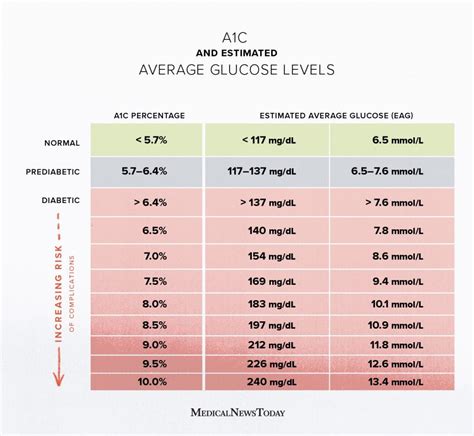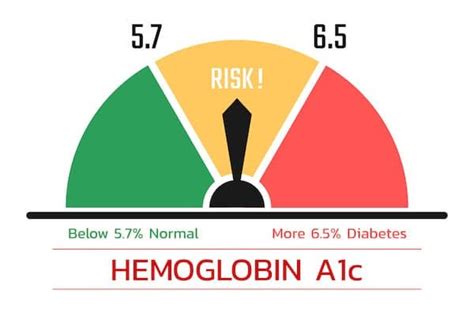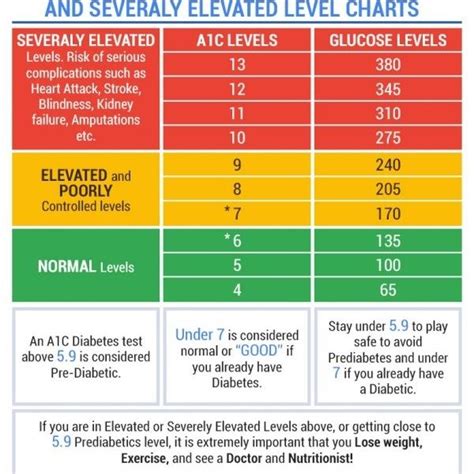Intro
Discover normal A1c levels and learn how to achieve optimal blood sugar control, understanding average A1c ranges, and diabetes management through healthy lifestyle choices and medical guidance.
Maintaining normal A1c levels is crucial for individuals with diabetes, as it helps prevent complications and ensures overall health. The A1c test, also known as the hemoglobin A1c or HbA1c test, measures the average blood glucose levels over the past 2-3 months. It's essential to understand the importance of A1c levels and how to maintain them within a normal range. In this article, we will delve into the world of A1c levels, exploring what they mean, how they are measured, and the benefits of maintaining normal levels.
The A1c test is a vital tool for managing diabetes, as it provides a comprehensive picture of blood glucose control. By measuring the percentage of glucose attached to hemoglobin, the test can detect even slight changes in blood sugar levels. This information is invaluable for individuals with diabetes, as it helps them make informed decisions about their treatment plan and lifestyle choices. Moreover, maintaining normal A1c levels can significantly reduce the risk of diabetes-related complications, such as heart disease, kidney damage, and nerve damage.
Understanding A1c levels is not just important for individuals with diabetes; it's also crucial for those who are at risk of developing the condition. Factors such as family history, obesity, and physical inactivity can increase the likelihood of developing diabetes. By monitoring A1c levels and making healthy lifestyle choices, individuals can reduce their risk of developing diabetes and maintain overall health. In the following sections, we will explore the benefits of maintaining normal A1c levels, the working mechanisms of the A1c test, and provide practical tips for achieving and maintaining normal levels.
What are Normal A1c Levels?

Benefits of Maintaining Normal A1c Levels
Maintaining normal A1c levels has numerous benefits, including: * Reduced risk of diabetes-related complications, such as heart disease, kidney damage, and nerve damage * Improved blood sugar control, which can help prevent episodes of hypoglycemia (low blood sugar) and hyperglycemia (high blood sugar) * Enhanced overall health and well-being * Increased energy levels and reduced fatigue * Improved mental health and reduced risk of depression and anxietyHow is the A1c Test Measured?

Interpreting A1c Test Results
Interpreting A1c test results is crucial for understanding blood glucose control. The results can be classified into several categories, including: * Normal: Below 5.7% * Prediabetes: 5.7% to 6.4% * Diabetes: 6.5% or higher It's essential to consult with a healthcare provider to determine the optimal A1c level for each individual and to develop a plan for maintaining normal levels.Factors that Affect A1c Levels

Practical Tips for Maintaining Normal A1c Levels
Maintaining normal A1c levels requires a comprehensive approach that includes: * Eating a balanced diet that is low in sugar, refined carbohydrates, and saturated fats * Engaging in regular physical activity, such as walking or swimming * Getting adequate sleep and practicing stress-reducing techniques, such as meditation or yoga * Monitoring blood glucose levels regularly and adjusting the treatment plan as needed * Working with a healthcare provider to develop a personalized plan for maintaining normal A1c levelsComplications of High A1c Levels

Preventing Complications of High A1c Levels
Preventing complications of high A1c levels requires a comprehensive approach that includes: * Maintaining normal A1c levels * Monitoring blood glucose levels regularly * Working with a healthcare provider to develop a personalized plan for preventing complications * Engaging in regular physical activity and eating a balanced diet * Getting adequate sleep and practicing stress-reducing techniquesTreatment Options for High A1c Levels

Working with a Healthcare Provider
Working with a healthcare provider is essential for maintaining normal A1c levels and preventing complications. A healthcare provider can help: * Develop a personalized plan for maintaining normal A1c levels * Monitor blood glucose levels regularly * Adjust the treatment plan as needed * Provide education and support for maintaining a healthy lifestyleWhat is a normal A1c level?
+A normal A1c level is typically below 5.7% for individuals without diabetes and less than 7% for individuals with diabetes.
How is the A1c test measured?
+The A1c test measures the percentage of glucose attached to hemoglobin, a protein in red blood cells.
What are the benefits of maintaining normal A1c levels?
+Maintaining normal A1c levels can reduce the risk of diabetes-related complications, improve blood sugar control, and enhance overall health and well-being.
In summary, maintaining normal A1c levels is crucial for individuals with diabetes and those at risk of developing the condition. By understanding the importance of A1c levels, how they are measured, and the benefits of maintaining normal levels, individuals can take control of their health and reduce the risk of complications. We invite you to share your thoughts and experiences with A1c levels in the comments below. If you found this article informative, please share it with others who may benefit from this information. Together, we can promote healthy living and reduce the risk of diabetes-related complications.
